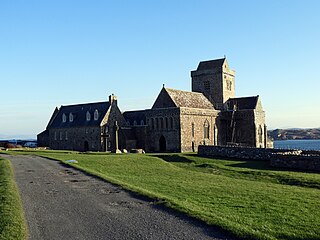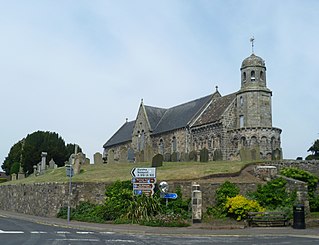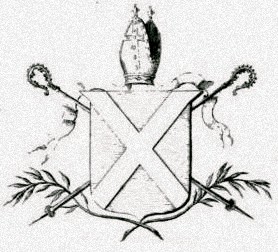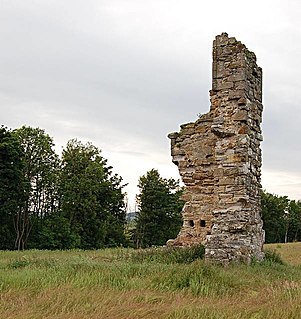Related Research Articles

Lindisfarne, also called Holy Island, is a tidal island off the northeast coast of England, which constitutes the civil parish of Holy Island in Northumberland. Holy Island has a recorded history from the 6th century AD; it was an important centre of Celtic Christianity under Saints Aidan of Lindisfarne, Cuthbert, Eadfrith of Lindisfarne and Eadberht of Lindisfarne. After the Viking invasions and the Norman conquest of England, a priory was re-established. A small castle was built on the island in 1550.

The Picts were a group of peoples who lived in what is now northern and eastern Scotland during Late Antiquity and the Early Middle Ages. Where they lived and what their culture was like can be inferred from early medieval texts and Pictish stones. Their Latin name, Picti, appears in written records from the 3rd to the 10th century. Early medieval sources report the existence of a distinct Pictish language, which today is believed to have been an Insular Celtic language, closely related to the Brittonic spoken by the Britons who lived to the south.

Fife is a council area, historic county, registration county and lieutenancy area of Scotland. It is situated between the Firth of Tay and the Firth of Forth, with inland boundaries with Perth and Kinross and Clackmannanshire. By custom it is widely held to have been one of the major Pictish kingdoms, known as Fib, and is still commonly known as the Kingdom of Fife within Scotland. A person from Fife is known as a Fifer. In older documents the county was very occasionally known by the anglicisation Fifeshire.

A Pictish stone is a type of monumental stele, generally carved or incised with symbols or designs. A few have ogham inscriptions. Located in Scotland, mostly north of the Clyde-Forth line and on the Eastern side of the country, these stones are the most visible remaining evidence of the Picts and are thought to date from the 6th to 9th century, a period during which the Picts became Christianized. The earlier stones have no parallels from the rest of the British Isles, but the later forms are variations within a wider Insular tradition of monumental stones such as high crosses. About 350 objects classified as Pictish stones have survived, the earlier examples of which holding by far the greatest number of surviving examples of the mysterious symbols, which have long intrigued scholars.

Anstruther is a small coastal resort town in Fife, Scotland, situated on the north-shore of the Firth of Forth and 9 mi (14 km) south-southeast of St Andrews. The town comprises two settlements, Anstruther Easter and Anstruther Wester, which are divided by a stream, the Dreel Burn. With a population of 3,500, it is the largest community on the Firth of Forth's north-shore coastline known as the East Neuk. To the east, it merges with the village of Cellardyke.
The Isle of May is located in the north of the outer Firth of Forth, approximately 8 km (5.0 mi) off the coast of mainland Scotland. It is about 1.5 kilometres long and 0.5 kilometres wide. The island is owned and managed by NatureScot as a national nature reserve. There are now no permanent residents, but the island was the site of St Adrian's Priory during the Middle Ages.

Kilrenny is a village in Fife, Scotland. Part of the East Neuk, it lies immediately to the north of Anstruther on the south Fife coast.

Iona Abbey is an abbey located on the island of Iona, just off the Isle of Mull on the West Coast of Scotland.

St Athernase Church is a Romanesque church located in Leuchars, Fife, Scotland. It is a Category A listed building and remains in use as a Church of Scotland parish church.
Christianity in Medieval Scotland includes all aspects of Christianity in the modern borders of Scotland in the Middle Ages. Christianity was probably introduced to what is now Lowland Scotland by Roman soldiers stationed in the north of the province of Britannia. After the collapse of Roman authority in the fifth century, Christianity is presumed to have survived among the British enclaves in the south of what is now Scotland, but retreated as the pagan Anglo-Saxons advanced. Scotland was largely converted by Irish missions associated with figures such as St Columba, from the fifth to the seventh centuries. These missions founded monastic institutions and collegiate churches that served large areas. Scholars have identified a distinctive form of Celtic Christianity, in which abbots were more significant than bishops, attitudes to clerical celibacy were more relaxed and there were significant differences in practice with Roman Christianity, particularly the form of tonsure and the method of calculating Easter, although most of these issues had been resolved by the mid-seventh century. After the reconversion of Scandinavian Scotland in the tenth century, Christianity under papal authority was the dominant religion of the kingdom.

Clunie is a small settlement in Perthshire, Scotland, four miles west of Blairgowrie. It lies on the western shore of the Loch of Clunie.
Marnock or Marnock of Kilmarnock, also known as Marnan of Narnach, Marnanus, Marnocalso or originally Ernin was a Scottish monk, bishop and saint.
Saint Cathan, also known as Catan, Cattan, etc., was a 6th-century Irish monk revered as a saint in parts of the Scottish Hebrides.

The Diocese or Archdiocese of St Andrews was a territorial episcopal jurisdiction in early modern and medieval Scotland. It was the largest, most populous and wealthiest diocese of the medieval Scottish church, with territory in eastern Scotland stretching from Berwickshire and the Anglo-Scottish border to Aberdeenshire.
Saint Adrian of May was a martyr-saint of ancient Scotland, whose cult became popular in the 14th century. He is commemorated on 3 December. He may have been a bishop of Saint Andrews.

The Brandsbutt Stone is a class I Pictish symbol stone in Inverurie, Aberdeenshire, Scotland.

The Christianisation of Scotland was the process by which Christianity spread in what is now Scotland, which took place principally between the fifth and tenth centuries.

Scoonie is a settlement and parish in Fife, Scotland, the parish contains the town of Leven. It is bordered on the north by the parishes of Kettle and Ceres, on the east by the parish of Largo, on the south by the parishes of Markinch and Wemyss, and on the west by the parishes of Markinch and Kennoway. It extends about 4+1⁄2 miles north to south. Its width varies between 5⁄8 and 2+3⁄4 mi . The parish is on the coast of the Firth of Forth, with a coastline of about 1+1⁄2 mi (2.4 km) The area of the parish is 4,107 acres.
References
- ↑ Charles-Edwards, T.M. (2006). The Chronicle of Ireland. p. 157.
- 1 2 Clancy, Thomas Owen (2008). "Deer and the early church in North-Eastern Scotland". In Forsyth, Katherine (ed.). Studies on the Book of Deer. pp. 375–77.
- 1 2 3 Yeoman, Peter (1998). "Pilgrims to St Ethernan: the Archaeology of an Early Saint of the Picts and Scots". In Crawford, Barbara E. (ed.). Conversion and Christianity in the North Sea World. St Andrews. pp. 75–91.
- 1 2 3 Taylor, Simon; Márkus, Gilbert (2009). The Place-Names of Fife, Vol. 3: St Andrews and the East Neuk. pp. 323–26.
- ↑ "Saints in Scottish Place-Names - Ethernan, Iternan (ns)". saintsplaces.gla.ac.uk. Retrieved 2 March 2019.
- ↑ Historic Environment Scotland. "Scoonie (31328)". Canmore . Retrieved 2 March 2019.
- ↑ Historic Environment Scotland. "Brodie, Rodney's Stone (15529)". Canmore . Retrieved 2 March 2019.
- ↑ Historic Environment Scotland. "Auchenblae, Fordoun Parish Church, Fordoun Stone (36458)". Canmore . Retrieved 2 March 2019.
- ↑ "Fife Place-name Data :: Kilrenny". fife-placenames.glasgow.ac.uk. Retrieved 2 March 2019.
- ↑ "Anstruther Parish Church - Anstruther Easter, Fife - Places of Worship in Scotland | SCHR". scottishchurches.org.uk. Retrieved 2 March 2019.
- ↑ "The Anstruther Church - Anstruther Wester, Fife - Places of Worship in Scotland | SCHR". scottishchurches.org.uk. Retrieved 2 March 2019.